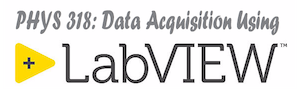Today we look at a LabVIEW Core 1 module called Grouping Data of Mixed Data Types that focuses on a structure called a cluster. A cluster is a grouping of LabVIEW objects that do not have to have the same data type. You have see a couple of uses of clusters already. The Error In and Error Out terminals are clusters that contain a boolean to indicate if there is an error, a numeric to indicate an error number, and a string to describe the source of the error. Another example where you used a cluster was when you bundled three numeric values (Low Temperature Limit, High Temperature Limit, and Actual Temperature) into a cluster to place the three values onto a chart in three separate data traces.
Access LabVIEW Core 1 Course- Core 1: 13. Grouping Data of Mixed Data Types
We will also take a look at the first module in the Sensors and Signals series in the Using NI-DAQmx with LabVIEW course. This module is called Measuring Temperature. We have already used a thermistor to measure temperature so some of this module will be review. However, the module will also discuss other sensors such as thermocouples and RTDs for measuring temperature.
Access Using NI-DAQmx Course- DAQmx: SS 1. Measuring Temperature
The following pages describe what is meant by a control system, what control theory is, the difference between open-loop and closed-loop control, a control approach called PID (proportional, integral, derivative), and how to use PID within LabVIEW. We will use PID to control the temperature of a small thermal plant but you should understand that PID control is used in many, many examples in our everyday lives.
The focus today will be to get a good start on the Thermostat assignment. If possible come to class with your circuit for this assignment set up.



